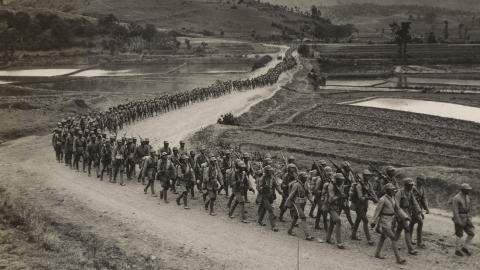History of World War 2: D-Day
Do you realise that by the time you wake up in the morning 20,000 men may have been killed?
Churchill to his wife the night before D-Day
On 6 June 1944, just after midnight, the Allied assault upon Hitler's 'Fortress Europe' began. The operation caught the German military high command unaware. Low tides and bad weather – combined with Allied deception plans – had convinced the Germans that an attack was unlikely at that time. As more than 1,000 British bombers began to pummel Normandy's coastal defences, Rommel, commanding German defences in France, was in Germany celebrating his wife's birthday.
The initial Allied assault was made by airborne infantry, who secured key bridges and crossroads on the flanks of the landing zone. Some of their most important and celebrated achievements included the capture of Pegasus Bridge and the town of Sainte-Mère-Eglise. Commandos also attacked key targets ahead of the main landings. One remarkable feat was the attack by US Rangers on Pointe-Du-Hoc, a headland which housed a coastal battery that threatened the landing beaches. The successful assault involved scaling a 30 metre cliff face under German fire.
Early Allied success was aided by the confused German reaction. The first confirmation of a large-scale attack did not arrive until 2:15 am; that an invasion was in progress was not confirmed until 4:15. It was only at 6 am, when Normandy's defenders saw the horizon obscured by an unbroken line of Allied ships, that all doubt was removed. Along nearly 100 kilometres of coast, Allied warships and aircrafts. At 6:30, US soldiers went ashore by landing craft at Utah and Omaha beaches. An hour later, the British and Canadians arrived at the beaches of Gold, Juno and Sword. Fortuitously, troops at Utah accidently landed two kilometres from their target, on a virtually unguarded beach. The landing zone was quickly secured with few losses.
On Omaha Beach, where aerial bombardment had done little to dent German defences, the Americans met fierce resistance. From cliff-top bunkers, the defenders pummelled US troops with machine gun fire and shells as soon as landing craft ramps were lowered. Those who made it ashore found it impossible to advance across 200 metres of open beach. Amphibious tanks intended to cover the infantry's advance had sunk in the rough seas. The news from Omaha was so bad that the landings there were almost called off, but eventually small groups of American infantry worked their way around the German defences, outflanked and stormed them, allowing the beachhead to be secured. But Omaha cost the Americans more than 2,000 casualties.
When British and Canadian troops landed at 7.30, supported by tanks, the tide was high, leaving fewer metres of beach to traverse. Although mines sunk a number of boats, soldiers succeeded in silencing German machine guns within half an hour. At the day's end, although they had not yet taken their objective of Caen, the soldiers had penetrated six kilometres inland, and their foothold in Normandy was secure. At 6pm, when Churchill addressed the House of Commons, it was to announce the astounding success of an operation which would go down in military legend.
Did you know?
The Normandy landings were the largest amphibious operation in history. In one day, 175,000 troops landed on the Normandy coast, with the help of more than 5,000 ships, crewed by 195,700 personnel from the Allied navies and merchant navies.
















